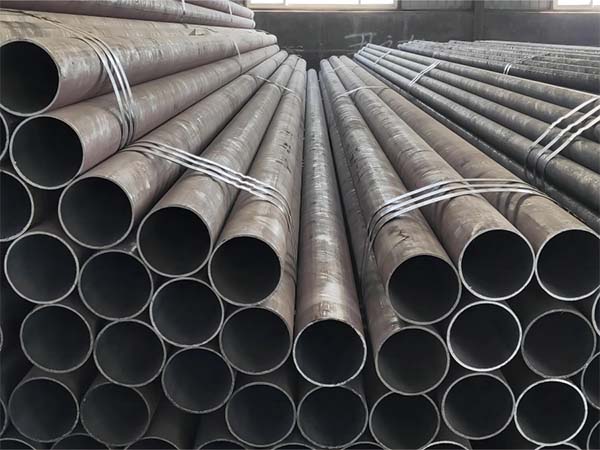European standards
EN 10210 and
EN 10219 are two common types of
ERW structural steel pipe standards, which differ in production processes, performance and application fields. A correct understanding of the differences between the two is helpful for choosing the most suitable structural steel pipe in the project.

E
N 10210 pipe - Hot-formed hollow steel section
The EN 10210 standard specifies the hot-formed structural hollow steel of non-alloy steel and fine-grained steel.
Production process: Formed and welded at high temperature, which belongs to hot finishing.
Advantages and features: Uniform structure, low residual stress, excellent toughness, and particularly suitable for low-temperature and dynamic load environments.
Typical applications: Bridges, offshore platforms, power facilities, high-rise buildings and other structural projects with high safety requirements.
Common steel grades include S235JRH, S275J2H, S355J2H, etc.
EN 10219 pipe - Cold-formed hollow steel section
The EN 10219 standard is applicable to hollow steel sections of welded structures formed by cold bending.
Production process: Bent into shape at room temperature and then subjected to resistance welding (ERW).
Advantages and features: High dimensional accuracy, high production efficiency, and more competitive cost.
Typical applications: factories, light steel structures, scaffolding, guardrails, agricultural machinery and other general projects.
Common steel grades include S235JRH, S275J0H, S355J2H, etc.
1. The differences in the forming process
The main difference between EN 10210 and EN 10219 lies in the different forming methods.
EN 10210 is formed and welded under high-temperature conditions using the Hot Finished process, and then a uniform metallographic structure is obtained through cooling. This method can effectively eliminate residual stress, endowing the pipe with better toughness and stable mechanical properties, and is particularly suitable for environments with low temperatures and impact loads.
EN 10219 adopts the Cold Formed process, which is bent into shape at room temperature and then welded. The advantages of this process are high dimensional accuracy, fast production efficiency and relatively low cost. However, it retains a certain amount of residual stress inside the pipe, and its toughness and low-temperature performance are slightly inferior to those of thermoformed products.
For this reason, EN 10210 tubes are often used in engineering projects with higher safety requirements, such as Bridges, offshore platforms, high-rise buildings and energy facilities; The EN 10219 tube is more widely applied in cost-sensitive fields such as general building structures, light steel structures and mechanical manufacturing.
2. Performance comparison
EN 10210 tube: It features more stable performance, better toughness and ductility, and is particularly suitable for structural engineering under impact loads, low-temperature and heavy-load conditions.
EN 10219 tube: It features higher dimensional accuracy and lower production cost, making it suitable for general building structures and projects with high economic requirements.
3. The differences in application fields
EN 10210 tube (Thermoforming)
Because the thermoforming process can eliminate residual stress and ensure toughness and stability, EN 10210 tubes are more suitable for high-demand engineering fields:
Bridges and large-scale infrastructure: Bearing heavy loads and dynamic stresses
Marine engineering and port facilities: Low-temperature resistance, impact resistance
Power and petrochemical projects: transmission towers, energy pipe galleries, and support for petrochemical equipment
High-rise and heavy steel structure buildings: They have extremely high requirements for safety and long-term stability
Extreme environment applications: Cold regions or situations where impact loads need to be resisted
EN 10219 tube (cold formed)
The cold forming process brings high dimensional accuracy and cost advantages, making EN 10219 tubes more suitable for conventional and economical projects:
General building structures: factories, warehouses, commercial buildings
Light steel structure projects: carports, movable houses, temporary facilities
Municipal engineering: guardrails, road facilities, pipe gallery supports
Scaffolding and construction equipment: Temporary support structures
Agriculture and machinery equipment: greenhouses, agricultural machinery structural components
Cost-sensitive projects: Engineering works that do not have high performance requirements but focus on price competitiveness
Why choose ERW pipes?
As an important category of structural and industrial steel pipes, ERW pipes have the following advantages:
The weld seams are uniform and the appearance is smooth
The production cost is lower than that of seamless steel pipes
We can supply different sizes and materials to meet various engineering requirements
It is widely applied in industries such as construction, energy, petrochemicals, machinery and municipal services
Whether it is EN 10210 hot-formed hollow steel section or EN 10219 cold-formed hollow steel section, they are both indispensable structural steel pipes in modern engineering.
